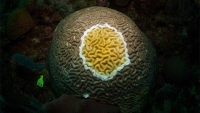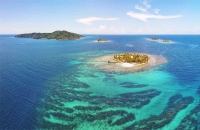What is Nitrox? It is safe to use it? What are the benefits?
In recreational diving, Nitrox or Enriched Air Nitrox (EAN), refers to any gas mixture composed of nitrogen and oxygen with an oxygen concentration higher than 21%. Since air is made of 21% oxygen and 78% nitrogen, a higher concentration of oxygen leads to a lower concentration of nitrogen which gives important benefits for divers.

The benefits of diving with EAN are tremendous, however there are few things to take into serious consideration to avoid potential risks. You also need to understand the oxygen partial pressures (ppO2) and depth limitations and don't forget that Nitrox certification is mandatory in order to dive with enriched air.
Here below a list of benefits of diving with nitrox but also few risks we need to be aware of.
What is Nitrox? It is safe to use it? What are the benefits?
In recreational diving, Nitrox or Enriched Air Nitrox (EAN), refers to any gas mixture composed of nitrogen and oxygen with an oxygen concentration higher than 21%. Since air is made of 21% oxygen and 78% nitrogen, a higher concentration of oxygen leads to a lower concentration of nitrogen which gives important benefits for divers.
The benefits of diving with EAN are tremendous, however there are few things to take into serious consideration to avoid potential risks. You also need to understand the oxygen partial pressures (ppO2) and depth limitations and don't forget that Nitrox certification is mandatory in order to dive with enriched air.
Here below a list of benefits of diving with nitrox but also few risks we need to be aware of.

BENEFITS
• Longer bottom time
What people love the most about diving with Nitrox is that it allows divers to stay underwater for a much longer time. During the dive, the nitrogen in the air that we breathe gets into our body; in the blood, muscle, tissues and even in our bones. This is because of the pressure around us, and the deeper we go and the longer we stay the more nitrogen we will absorb.
How many times have we found ourselves enjoying a beautiful reef but unfortunately we must start our ascend to avoid decompression stops? Thanks to the lower concentration of nitrogen in Nitrox we can extend our time underwater and enjoy the undersea world for much longer.
According to the NOAA no-decompression dive tables we can dive with air at a depth of 60 feet (18.3 mt) for no longer than 60 minutes without having to do mandatory decompression stops. With Nitrox at 32% of oxygen concentration we can stay at the same depth for 92 minutes and up to 125 minutes with Nitrox at 36%, more than double the time.
Download the NOAA no-decompression dive tables Nitrox on the bottom of this blog
• Less time between dives
Another great benefit of diving with Nitrox is that it allows divers shorter surface intervals. This means we need to wait less time before getting back in the water. When we dive with Nitrox we absorb less nitrogen while we are underwater, therefore, there is a lesser amount of residual nitrogen in our body to off gas between dives. For example, diving with air at 60 feet (18.3 mt) for 45 minutes will put us in pressure group H. We will have to wait no less than 5 hours and 17 minutes in order to make another dive at the same depth for the same time. Using Nitrox at 32% for the same dive instead of air will put us in pressure group G. Which means we will be able to make the same dive at the same depth for the same time after only 53 minutes on the surface.
• More diving during your holiday
Many diving resorts and liveaboards offer free Nitrox to those clients certified to use it. Diving repeatedly with enriched air will make your body accumulate less residual nitrogen. This will allow you to dive more frequently and safer during your vacation. Using enriched air during your dive could potentially gain you hours of additional dive time over the course of the same week holiday.
• Less tiring
Even if it has not been scientifically proven, it is well established amongst divers, the belief that diving with Nitrox will reduce your post dive fatigue. Many divers claim to feel less tired after diving with enriched air. This theory could be explained with the fact that less nitrogen in a diver body also reduces the amount of microbubbles in body tissues which could have a direct consequence on diver fatigue.
• Very easy to get.
Getting certified for enriched air diving is very easy. It can mostly be done online in very little time, for a very reasonable price.
RISKS AND LIMITS
There is one fundamental risk involved in diving with Nitrox. It is related to the increase of the oxygen partial pressure (ppO2) which can potentially cause convulsions if limits are exceeded. We need to know that oxygen can become toxic under a certain pressure level. Increasing the concentration of oxygen in the tank will also increase the partial pressure of it and this will consequently lower the depth limit.
There is approximately 21% of oxygen in the air we breathe. This means that the normal partial pressure of oxygen in the atmosphere is about 0.2 bar. A healthy person can tolerate between 1.4 and 1.6 ppO2 of oxygen before incurring risks in the so-called "oxidosis" (acute oxygen toxicity or oxygen convulsions). 0.2 bar of oxygen partial pressure will translate for a diver in a depth of 230ft ( 70 mt) diving with air. If we dive with nitrox, the oxygen partial pressure increases depending on the percentage of oxygen we choose, consequently decreasing the depth limits we are allowed to dive.
According to NOAA the maximum single exposure limits recommended to avoid oxygen toxicity are 45 minutes at 1.6 bar, 120 minutes at 1.5 bar, 150 minutes at 1.4 bar, 180 minutes at 1.3 bar and 210 minutes at 1.2 bar.
Bottom line, never exceed a 1.4 ppO2 in order to be safe. This translates to never going deeper than 112 ft ( 34 mt) if you dive with Nitrox 32% and 95 ft (29 mt) if you dive with Nitrox 36%, two of the most frequent Nitrox mixes.
Divers must always be aware of the oxygen concentration in their tank and set their diving computer based on it. One must never exceed the depth limit after which the oxygen could potentially cause convulsions. While extremely rare, oxygen convulsions can occur when diving recklessly and exceeding the training limits. As long as you stay within the limits, the risks are almost zero.
Download the NOAA no-decompression dive tables Nitrox



